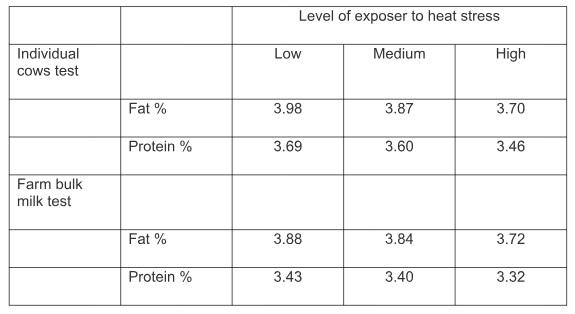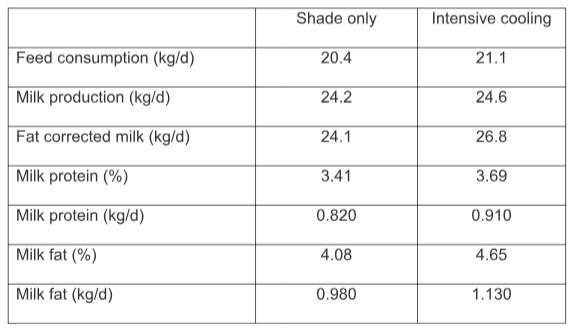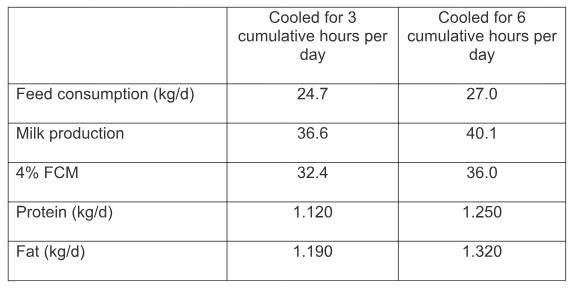Effect of heat stress and cooling the cows in the summer on milk fat and protein content
Published: July 12, 2023
By: Israel Flamenbaum Ph.D (Cow Cooling Solutions, Ltd)
When talking about the negative impact of heat stress on milk production, we usually refer to the impact on milk volume (liters per cow per day or per lactation). The reality is that this is only part of the problem, which causes economic losses to farmers and dairy industry. As will be presented in this article, heat stress negatively affects milk fat and protein content and reduce milk quality, by increasing milk Somatic Cell Count (SCC) and bacterial count. In some cases, especially in countries where great part of national milk is processed to dairy products (especially cheeses), the losses caused due to the drop in milk fat and protein content and quality are greater than just that of milk volume. On the other hand, I will describe in the second part of this article, the advantages of proper implementation of heat mitigation means.
One of the largest “cheese producers” in the world is Italy, where almost 75% of national milk is processed into cheeses. Italian researchers (Bernabucci et al 2015, J. Dairy Sci. 98:1815) analyzed cow’s milk, collected in winter and summer and found that for all major components (milk fat, protein, total solids and fat-free solids), the lowest values were observed in the summer and the highest values were observed in winter. Milk casein fraction showed significantly lower values in summer and higher values in winter (22.6 and 27.5 gr. per liter of milk), respectively. This phenomenon negatively affects the manufacturing properties of cheese, one of the main and most important products that Italy exports to the world.
Another research from Italy, published recently (Moore et. al. J. Dairy Sci. 2022, 106:4042), analyzed milk samples (taken from individual cow’s test and farm bulk test), in thousands farms in north Italy. Effect of Low, Medium and high heat stress conditions, (characterized by number of days with average Temperature Humidity Index (THI) above threshold in tested period, showed that fat and protein content in the milk were reduced, as heat stress conditions were increased. Data in table 1.
Table 1 – Fat and protein content by month, in milk of individual cows, and farm bulk milk, when exposed to low, medium, and high heat stress conditions.

From the presented in table 1 we can see a 10% drop in fat and protein content in the milk, when cows are exposed to high THI for long time. We assume that if we add this drop to the decline in milk volume under same conditions, the total milk fat and protein lost will be even greater (and this is what interest cheese industry). One of the Italian studies calculated the economic value of such a decrease in milk content and found that it is around 1.5 Euro cent per each liter of milk produced (close to 4% of milk price and with a daily value of 0.6 EUR per cow/day). Based on more than 500,000 farm bulk samples taken from dairy farms in Lombardy (largest milk producing region in Italy), it was found that, while for milk volume production daily average THI threshold is around 68, it is lower for milk protein production (THI 65) and even lower for milk fat (THI 50). In other words, milk fat and protein in the milk start dropping earlier than milk volume.
Research conducted in Iran and published recently (Toghdory et. al. 2022 Animal 12:2484) tested 55,000 farm bulk milk tests, taken from dairy farms in north of the country, between 2016 and 2021. Protein and fat content in the milk samples taken in months where temperatures were high (31 C) were 4.2% and 5.7% lower, respectively, as compared to periods where temperature was 18 C or lower. Relative humidity during warm periods played an important role in the influence on milk composition. The increase in average daily relative humidity from 54% to 82%, caused the drop of 3.6% and 4.8% in milk protein and fat content, respectively.
Brazilian dairy sector is the biggest in south America and one of the largest in the world, with near 15 million cows and 36 billion tons of milk produced annually. Brazil dairy sector is concentrated in two main regions, Minas and Goisa (south east), warmer region with almost 180 and more stressful days per year, and in Santa Catarina and Rio Grande do Sul (south), with relatively cooler conditions and around 120 stressful days per year. As can be seen in the two figures, in both regions there is a significant drop in fat and protein in milk during summer months. In the regions of Santa Catarina (SC) and Minas Gerais (MG), the protein content of raw milk drops from 3.4% in the coolest season to 3.1% in the warmest season (a drop of almost 10%), while fat content of milk drops from 3.8% to 3.5% in the same periods (a drop of 8.5%).
Milk fat and protein content in milk per month, in the years 2013 – 2020 in dairy farms in SC and in MG are presented in the following figures.
Figure 1 – Fat and protein content in milk per month, in the years 2013 – 2020 in dairy farms in SC. (Fat in Green line and protein in yellow line).

Figure 2 – Fat and protein content in milk per month, in the years 2013 – 2020 in dairy farms in MG. (Fat in Green line and protein in yellow line).

As can be seen in the figures, the drop in milk fat and protein in warm seasons is almost the same in both regions, despite the difference in climate conditions.
Now, for the mechanisms:
The drop in milk protein in warm season can be related to downregulation of mammary protein synthetic activity, reduced casein synthesis, and lack of supply of the milk protein precursor by the cow’s digestive system. As for milk fat content, the decrease can be mainly attributed to the decrease in fiber consumption and cow’s rumination rate, which leads to a drop in rumen pH, and reduction in fat precursors in the digestive system and their supply to the mammary gland.
What happens when we cool the cows?
Alleviating heat stress by using intensive cooling strategies is an effective way to improve seasonal patterns of low fat and protein in milk. In this article, I will present some studies carried out recently, where the implementation of adequate cooling to cows prevents summer drop in milk fat and protein content.
In a recent study conducted by Chinese researchers, in collaboration with US scientists (Gao et al. 2022, J. Dairy Sci. 104:12139–12152), cows were divided into two groups. The first group received a moderate cooling treatment combining fans and sprinklers for a cumulative 3 hours per day, while the second group received shade only. The information presented in Table 2 below shows that cooling the cows increased milk protein percentage and total daily production by almost 10% and 13% for milk fat.
Table 2 - Feed intake, milk, protein and fat content in the milk of cooled and non-cooled cows

Authors of this article mentioned in their discussion that probably, providing a more intensive cooling treatment to cows in the early stages of lactation (as it is done in Israel today, with 6 cumulative hours of cooling per day), could yield even greater improvements in milk fat and protein production.
Such an experiment was conducted in Israel (Honig et al. 2012, J. Dairy Sci. 95:3736–3742), where high-yielding cows were cooled by a combination of sprinklers and forced ventilation, for different durations per day. One group (short cooling period) was cooled for 3 cumulative hours per day, while the other was cooled for 6 cumulative hours per day (long cooling period). As can be seen in Table 3 below, doubling cooling time per day significantly increased daily feed intake and total milk, protein and fat production.
Table 3 – Feed intake, milk, protein and fat content of cows cooled for 3 and 6 cumulative hours per day

The improvement in milk production, as well as fat and protein production, can also be achieved by cooling the cows during the dry period, occuring in summer. Another Israeli study (Adin et al 2009, Livestock Sci. 124:189), showed that intensive cooling of cows four times a day in the last 2 months of pregnancy, occurring in the summer, increased fat and protein content in the milk by 5%, in the first 90 days of subsequent lactation. From what has been described so far, there is no doubt that cooling the cows improves cow’s protein and fat production, and as cooling is provided for longer time per day, the improvement in high-yielding cows is greater.
Anyway, there is one more factor at work in this game and it is cow’s body condition at calving. In an experiment performed few decades ago, as part of my Ph. D thesis (Flamenbaum et. al. 1995, J Dairy Sci 78:2221), the body condition of high-yielding cows was nutritionally manipulated at the end of the previous lactation and in the dry period to achieve high or low body condition at calving, scheduled to occur in early summer. After calving, the cows in each body condition group were split, with half of the cows being intensively cooled, while the other group was given shade only. High body condition at calving with intensive cooling of the cows after calving in the summer, yielded the highest amount of fat and protein in the milk, in the first 150 days of lactation, occurring in the summer, while worst results were obtained in the cows that calved in low body condition and suffered heat stress after calving.
In conclusion - from the studies presented in this article it can be seen that proper cooling of cows has the potential to increase milk fat and protein percentage and total fat and protein content in milk by at least 10%. In other words, adequate cooling of cows in the warm season has the potential to completely eliminate the expected drop in fat and protein content in the milk of cows producing in the summer.
Related topics:
Authors:
Recommend
Comment
Share
17 de julio de 2023
Sir, have you also evaluated the effect in Milk production, Fat and SNF of feeding Betaine in summer to beat the heat, kindly advise on the same, Thank you
Recommend
Reply

Would you like to discuss another topic? Create a new post to engage with experts in the community.





.jpg&w=3840&q=75)